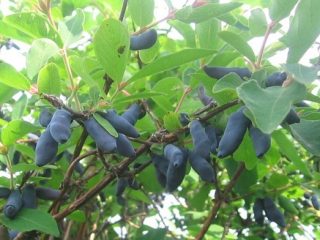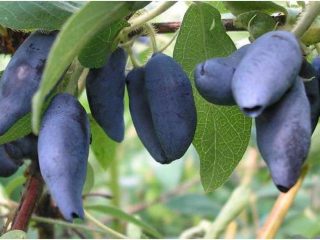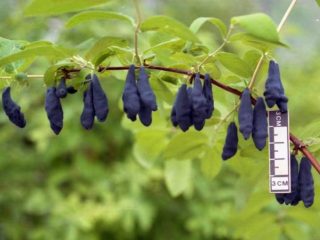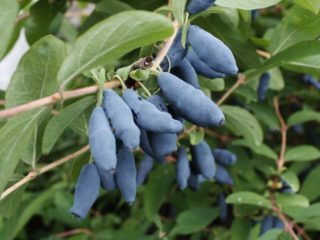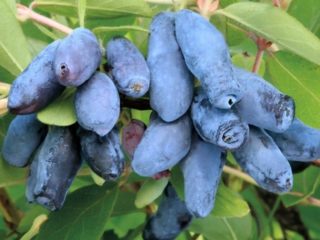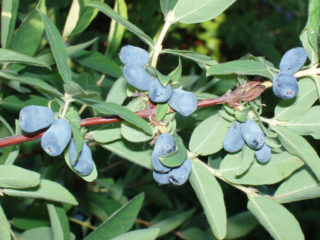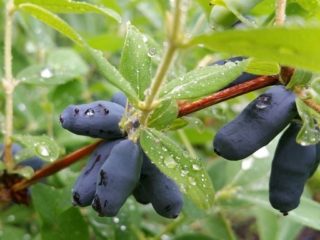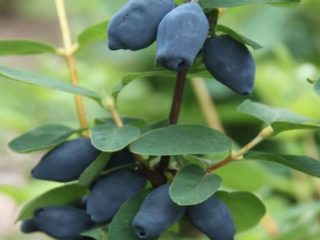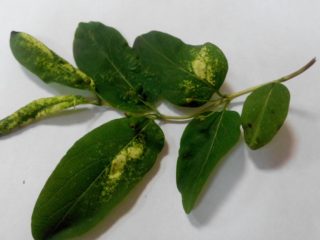Content
More than 190 species of plants from the Honeysuckle family are known. It grows mainly in the Himalayas and East Asia. Some wild species are found on the territory of the Russian Federation. One of the newest early ripening varieties is a shrub bred by the Tomsk enterprise “Bakcharskoye”: a detailed description of the honeysuckle variety Strezhevchanka, methods of its propagation, features of planting and care.
Description of honeysuckle variety Strezhevchanka
Edible honeysuckle (lonicera edulis) Strezhevchanka is a vigorous early variety. The bush is up to 180 cm high and 1.5 meters in diameter and has straight, spreading branches. The foliage is dark green, slightly matte. The variety is a dessert variety with high taste qualities. The plant blooms in May and continues to form buds for 15-20 days. The most abundant harvests can be expected from the fifth year after planting, and then for 3-5 years, depending on care. Then the yield begins to decline.
Record large berries, weighing up to 3 g, ripen abundantly and uniformly, and do not fall off. They are easy to collect, since the arrangement of the branches is quite sparse, and the fruits are located at the very tips. They are covered with a waxy coating, dark blue, almost black, spindle-shaped. Sweet and sour, juicy, with thin skin. They ripen in the first half of June. The yield of a bush on average reaches 2.4-2.8 kg of berries per bush, and with proper care and a favorable climate it can reach up to 4.5 kg. The disadvantages of the variety include the impossibility of machine picking of ripe berries and poor resistance to transportation due to increased juiciness and thin skin.
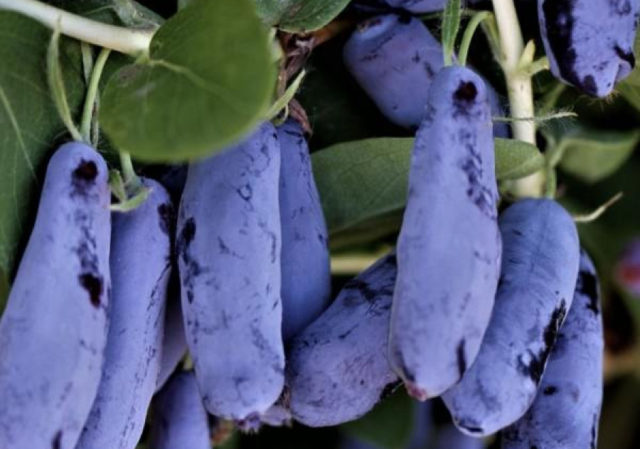
Honeysuckle Strezhevchanka is a standard crop that requires proper pruning
Planting and caring for honeysuckle Strezhevchanka
Like any other variety of honeysuckle, Strezhevchanka is unpretentious and very hardy. However, comfortable conditions are the key to a bountiful harvest, so it is worth following the rules of planting and caring for it.
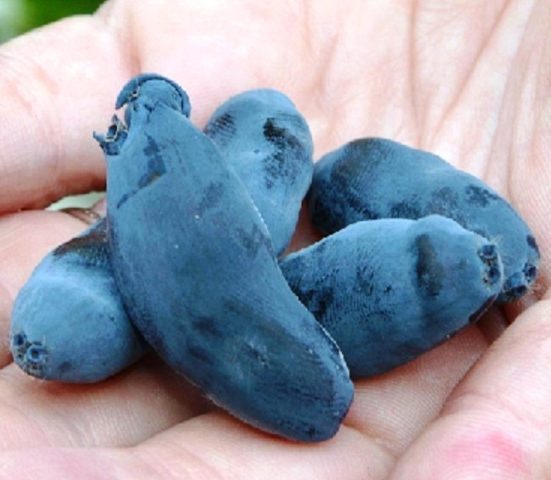
Ripe fruits become soft and very tender
Landing dates
Honeysuckle Strezhevchanka is an early ripening variety, awakening from sleep with the first warm days. Therefore, the best option would be autumn planting, at least a month before sub-zero temperatures. Specific dates vary by region.If in the northern and central regions of Russia this is September, then in the southern regions planting can be done until October or early November.
Selection and preparation of a landing site
Wild varieties of honeysuckle prefer sunny, open areas near forests and ponds:
- old fellings and burnt areas;
- forest glades and meadows;
- edges and outskirts of overgrown swamps;
- banks of rivers, lakes, streams, damp ravines.
Tolerates shrubs and light shade. Therefore, when preparing a planting site, it is worth taking into account the natural characteristics of honeysuckle. For Strezhevchanka honeysuckle you need:
- open, maximally illuminated place;
- protection from wind and drafts;
- well-warmed soil.
Southern slopes of hills, areas next to blank fences and walls of houses or outbuildings, and open courtyards are ideal. Honeysuckle Strezhevchanka is undemanding in terms of soil composition. The following types are allowed:
- peat bogs and gray forests;
- loams and aluminas;
- chernozems and sandy loams;
- sod-podzolic and volcanic sand.
The acid-base balance of the soil, at which the plant feels comfortable, is also very wide - from 4.5 to 7.5 pH. Honeysuckle should be provided with a high content of minerals and nutrients.
Landing rules
At the selected location, you need to dig a hole measuring 40x40 and 50 cm deep. The edges must be strictly vertical, and the bottom must be flat and horizontal. First, a drainage layer of turf, crushed stone, broken bricks and pebbles 8-10 cm high is poured. Then you should prepare a fertile soil mixture by mixing 1-2 buckets of compost, a liter of ash, half a bucket of humus and 50 g of superphosphate into the selected soil. If the soil is too heavy, you can add baking powder in the form of sand.The pits should be prepared 1-2 weeks before planting.
If the seedling has an open root system, then the soil should be piled up in such a way that the root collar is on the surface and the roots can be freely spread. Then the bush must be carefully sprinkled with soil and lightly pressed with your hand. If the plant is planned to be planted by transferring it from a pot, then the hole should be filled in such a way that the root ball rests on the ground without deepening the upper part - it should be flush with the soil level.
Planted plants must be well watered and mulched with any convenient material, from chopped straw and agrofibre to peat, husks or mowed grass.
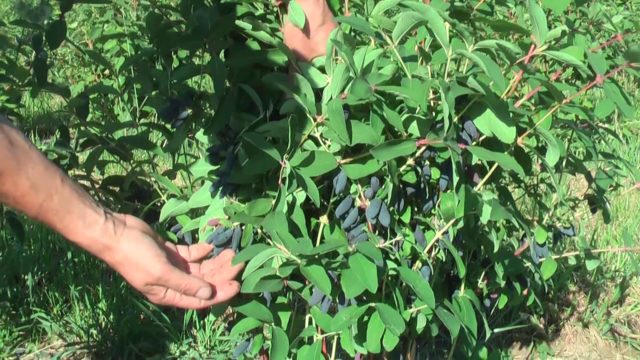
Honeysuckle Strezhevchanka in the third year after planting
Watering and fertilizing
Proper care of the shrub involves regular watering, 3-4 times during the period of active flowering, after harvesting and in the fall. Fertilizer application is necessary for 2-3 years after planting in the ground. Before flowering begins, fertilize with urea, and after harvesting, sprinkle with mullein solution. Honeysuckle Strezhevchanka is especially sensitive to the presence of potassium and phosphorus in the nutrient substrate. Therefore, in the fall it is necessary to fertilize the plantings with superphosphate and potassium salt.
Pruning honeysuckle variety Strezhevchanka
It is best to form the crown using a standard method - this greatly simplifies care and harvesting. Pruning should be done in late autumn, when the flow of sap slows down, starting at the age of six. Young apical shoots are not touched, since it is on them that the future harvest is formed. For young plants, sanitary pruning is practiced, with the removal of dried, diseased, damaged branches. An old bush can be trimmed to the height of the trunk.Such rejuvenation allows you to give a second life to the plant and obtain full harvests over the next years.
Wintering
Honeysuckle Strezhevchanka does not need special preparation for winter. In autumn you should:
- it is good to shed the falling asleep bushes;
- carry out pruning and fertilizing;
- remove old foliage;
- loosen and renew the mulch layer.
Reproduction of edible honeysuckle Strezhevchanka
Honeysuckle Strezhevchanka can reproduce in the following ways:
- cuttings. To do this, you need to select strong shoots 2-4 years old, 14-18 cm long with several living buds. The top cut should be straight, the bottom should be at an angle. Remove the leaves, except those remaining at the top, cut them in half. Place vertically in light fertile soil, under a glass jar. After 2-3 weeks, the rooted cuttings can be transplanted into open ground;
- dividing the bush. It should be done either in March or October. Dig up the selected bush on one side, cut off several branches along with pieces of root, and plant it in a permanent place of residence;
- layering. To obtain shoots, the lower branches should be bent to the ground, secured and buried. Secure the upper parts with pegs vertically. Sprinkle with a root formation stimulator. When new shoots appear and grow, they should be carefully separated from the mother branch, leaving each piece with a rhizome, and replanted.
Thus, from one Strezhevchanka honeysuckle bush you can get 5-10 new plants per season.
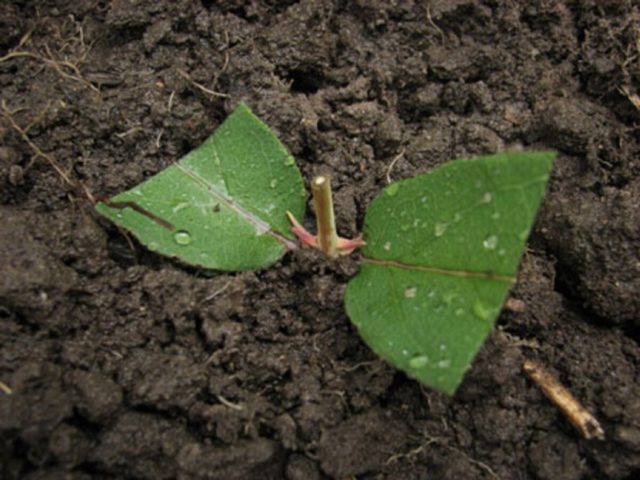
Rooted cuttings of Strezhevchanka honeysuckle
Pollinators of honeysuckle Strezhevchanka
To increase yield, it is recommended to plant several varieties of honeysuckle nearby to ensure cross-pollination. Strezhevchanka reacts with a record number of berries in the presence of pollinators such as:
- honeysuckle Delight and Yugana;
- Bakchar giant;
- The daughter of a giant and Silginka.
To ensure pollination, one of the above species is enough for 5-6 bushes.
Diseases and pests
Honeysuckle Strezhevchanka demonstrates unique immunity to common shrub diseases. Therefore, the main care consists of preventive measures, including folk remedies:
- Modern fungicides, sulfur, and urea help well against fungal diseases;
- bacterial and viral infections are not dangerous for a strong, healthy plant with good immunity;
- Treatments with alkaline solutions, ash, soda ash, and laundry soap help against aphids;
- Spraying with iodine preparations, whey, infusions of tomato and potato tops, plants whose smell is intolerable to insects has worked well;
- if massive accumulations of insects are found that threaten honeysuckle plantings, you should resort to industrially produced insecticides.
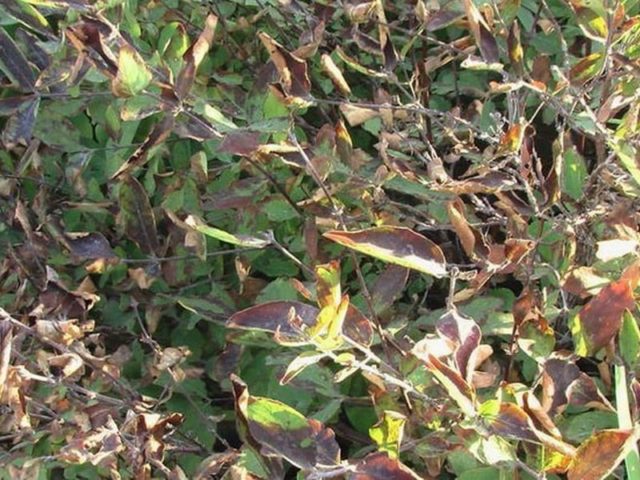
Strezhevchanka honeysuckle bushes affected by aphids
Conclusion
The description of the honeysuckle variety Strezhevchanka given by breeders attracted the attention of gardeners.Despite the fact that official testing of the variety has not yet been completed, Strezhevchanka honeysuckle has already proven itself in the most positive way. A tall bush with straight branches begins to flower in May, and fruits appear in June-July. Honeysuckle Strezhevchanka produces very juicy berries, with thin skin and a sweet-sour taste. They have high dessert qualities and are a storehouse of vitamins and minerals beneficial to the body. Suitable for use in cooking both fresh and processed.
